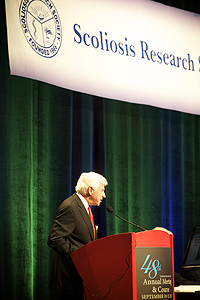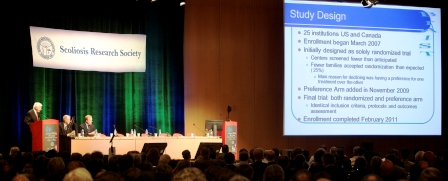
BrAIST Presentation
 Dr. Stuart Weinstein recently reported the results of the NIH-funded Bracing in Adolescent Idiopathic Scoliosis Trial (BrAIST) at the 48th Annual Meeting of the Scoliosis Research Society in Lyon, France. Simultaneously, the results were published online in the New England Journal of Medicine. Dr. Weinstein reported that bracing of adolescents with moderate scoliosis was effective treatment in the reduction of the number of patients who advance to the need for surgery. In addition, a dose response was found between the number of hours of brace wear and the success rate of bracing.
Dr. Stuart Weinstein recently reported the results of the NIH-funded Bracing in Adolescent Idiopathic Scoliosis Trial (BrAIST) at the 48th Annual Meeting of the Scoliosis Research Society in Lyon, France. Simultaneously, the results were published online in the New England Journal of Medicine. Dr. Weinstein reported that bracing of adolescents with moderate scoliosis was effective treatment in the reduction of the number of patients who advance to the need for surgery. In addition, a dose response was found between the number of hours of brace wear and the success rate of bracing.
Several medical centers worked together to perform the highest level of medical study, a randomized clinical trial, to answer the question of whether bracing is effective in growing children and adolescents with curves between 20 – 40 degrees. 242 patients participated in the study. Patients in the bracing group were assigned to wear a brace 18 hours per day (a typical bracing prescription). A special monitor was embedded in the brace to keep track of how long it was used per day. Patients in the observation-only group received no additional treatment. The end point of the study was “treatment failure” defined as progression of the scoliosis to =50 degrees or “treatment success” when skeletal maturity was reached without progression to 50 degrees.
72% of brace wearers avoided surgical recommendations, but only 48% of patients in the observational group. Furthermore, the rate of success achieved by those patients who wore the brace for 13 hours or more was greater than 90%, showing that the amount of time the brace is worn is very important. The study provided strong evidence to the value of brace treatment for those adolescents at high risk of progression of surgery.

In the past, the value of a screening examination for scoliosis has been debated due to inconclusive evidence of the success of non-operative treatment for scoliosis. This is no longer true as the evidence from the BrAIST study establishes the effectiveness of bracing as early, non-operative care. This may reduce the number of patients who progress to surgery and serve as a potential cost saving for the health care system and of great benefit to patients. Policy statements from professional organizations and governmental agencies regarding scoliosis screening in school programs and primary care settings will need to be reassessed in order to identify at-risk patients who will benefit from bracing for scoliosis.
This study was recently featured in the New York Times.
Visit the SRS Patients & Families section for more information about bracing.
